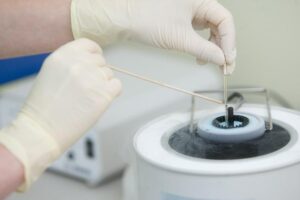Dry, cracked soles can feel uncomfortable and even painful. Sometimes, the cause is more than just dry skin. One common reason is a skin condition called Moccasin Tinea Pedis. It is a type of athlete’s foot that mostly affects the soles of the feet. The skin may look dry, rough, or scaly. In some cases, the edges of the feet may peel, and itching can occur.
Many people ignore these signs, thinking it’s only dryness. However, proper care is very important. If left untreated, the condition may get worse or spread. The good news is that it can be treated with the right steps. Regular foot hygiene, using the correct creams, and wearing clean socks can help a lot.
If your feet are showing these signs, it’s best to visit a professional. A trusted Podiatry Clinic in Edinburgh can give you the correct diagnosis and treatment. The podiatrist will guide you on how to care for your feet and stop the infection from returning.
Taking action early helps you avoid pain and keep your feet healthy. You don’t have to live with dry, cracked soles. With expert advice and proper care, your feet can feel soft and smooth again.
To help you learn more, here are five helpful sections below:
-
What Is Moccasin Tinea?
-
Early Signs to Watch For
-
Effective Daily Foot Care
-
Treatment Options in Town
-
Preventing Future Flare-Ups
What Is Moccasin Tinea?
Moccasin Tinea is a type of athlete’s foot that affects the soles and edges of your feet.
Instead of redness or itching alone, this condition appears as dry, scaly, and cracked skin that feels rough and uncomfortable.
Although it may look like common dryness, it is actually caused by a fungal infection that spreads if left untreated.
The infection grows in warm, moist environments, such as shoes, socks, and damp floors in shared spaces.
For this reason, it’s important to stay alert and take care of your feet regularly to avoid flare-ups.
Some people confuse this with eczema or dry skin and delay treatment, which leads to further damage and discomfort.
With early care, however, the infection can be controlled and fully treated using proper medication and hygiene.
In the next section, we’ll guide you through early signs that help you spot this condition before it worsens.
Knowing these early signs allows you to take action before the infection causes more harm and spreads to your nails.
Early Signs to Watch For
The first signs of Moccasin Tinea often go unnoticed because they closely resemble common foot dryness or rough skin.
You may notice dry, flaky skin around your heels or soles, followed by a slight itch or mild burning sensation.
As the condition progresses, the skin becomes thick, cracked, and may even peel around the edges of your feet.
If your feet feel itchy after removing shoes or socks, it could be an early sign of fungal infection.
You should not ignore these changes because early treatment gives better results and avoids long-term damage to your skin.
Sometimes, toenails may also change color or texture if the fungus spreads, which makes the condition harder to treat.
It is always a good idea to examine your feet weekly and keep track of any unusual changes or sensations.
Also, avoid scratching or peeling the skin, as it may lead to infection or further spreading.
Effective Daily Foot Care
Daily foot care is one of the best ways to prevent Moccasin Tinea from starting or getting worse over time.
Begin by washing your feet using mild soap and warm water, then dry them thoroughly, especially between your toes.
Apply antifungal cream if recommended, and use a moisturizer to keep your feet soft and prevent excessive dryness or cracking.
Wear clean, dry socks made from cotton, and avoid using synthetic materials that trap moisture and heat throughout the day.
Also, rotate your footwear regularly to let your shoes dry completely before wearing them again.
Avoid walking barefoot in public areas like locker rooms, pools, or shared showers, where fungal infections can easily spread.
Clean your bathroom floors regularly to remove any fungal spores and reduce the chances of reinfection.
With consistent daily care, you’ll keep your feet healthier and reduce the risk of painful fungal conditions.
Treatment Options in Town
If symptoms continue or worsen, visiting a Podiatry Clinic in Edinburgh is the best step toward treating Moccasin Tinea effectively.
Professionals will examine your feet carefully and confirm whether you have a fungal infection or a different skin condition.
They may prescribe antifungal medications, either creams or tablets, depending on the severity of your symptoms and skin damage.
Sometimes, medicated foot soaks or gentle exfoliation methods are also recommended to remove dry skin layers and speed healing.
Your podiatrist will also offer tips on daily care and hygiene practices to support your recovery and prevent flare-ups.
Never ignore recurring symptoms, as untreated infections may spread to your toenails or become resistant to common medicines.
You may also be advised on suitable footwear, socks, and creams to use during and after the healing period.
Preventing Future Flare-Ups
Prevention is just as important as treatment when it comes to avoiding recurring cases of Moccasin Tinea and cracked soles.
Start by making foot hygiene a daily habit—clean, dry, and inspect your feet before putting on socks or shoes.
Choose footwear that allows air to circulate and change your socks at least once daily or whenever they feel damp.
Use antifungal powders or sprays in your shoes to keep them free from moisture and fungus-friendly conditions.
Never walk barefoot in gym showers, public pools, or locker rooms, as these places are common sources of fungal infections.
Keep your bathroom floor clean and avoid sharing towels, socks, or slippers with others at home.
Check your feet weekly for signs of dryness, peeling, or cracking and apply creams as soon as symptoms appear.
If you feel unsure, always consult a podiatrist before the problem grows worse or spreads to your toenails.
With these habits in place, you’ll protect your feet and enjoy long-term comfort and healthy skin.
Conclusion
Moccasin Tinea may start with dry, cracked skin, but it can lead to more serious foot problems if ignored.
However, with early detection, proper daily care, and help from a Podiatry Clinic in Edinburgh, you can treat it easily.
By following preventive steps and staying alert to changes, your feet will stay smooth, clean, and infection-free every day.






